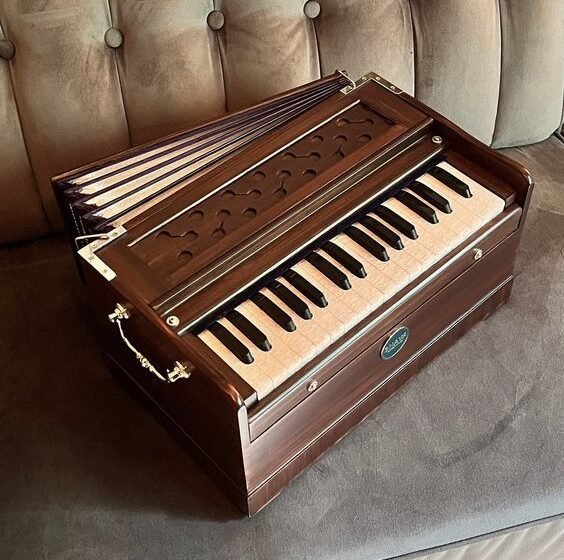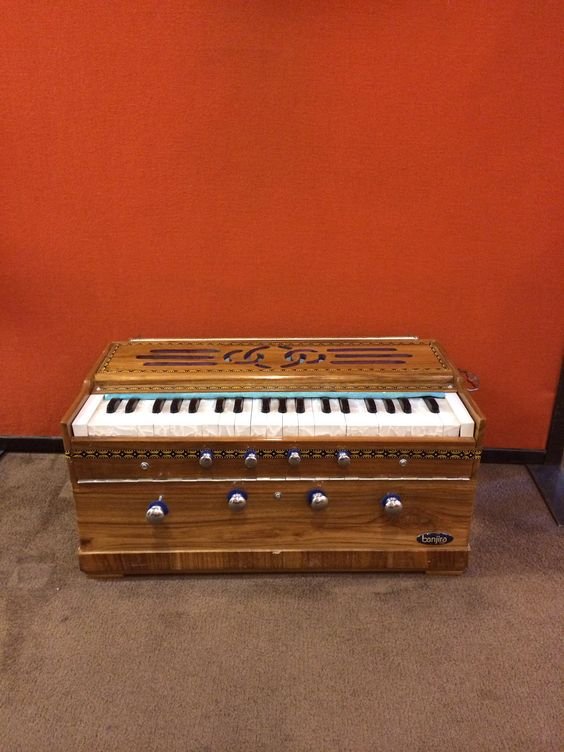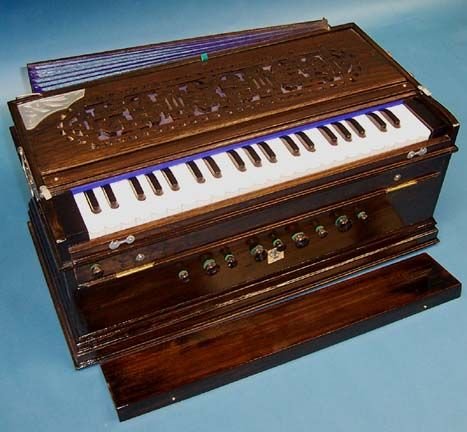Harmonium: The Classical Indian Instrument

INTRODUCTION
The harmonium is a musical instrument that has been a staple of Indian classical music for centuries. Its unique sound and versatility have made it a favorite among musicians and music lovers alike. Despite its popularity, many people do not fully understand the history and significance of the harmonium in Indian classical music. In this blog, we will delve into the rich history of the harmonium, exploring its evolution and its impact on the world of classical music. From its roots in Europe to its adoption and adaptation in India, we will examine the various aspects of this beloved instrument, including its design, sound, and cultural significance. Whether you are a seasoned musician or simply a music enthusiast, this guide will give you a comprehensive understanding of the harmonium and its place in Indian classical music.

ORIGIN OF HARMONIUM
The harmonium has its roots in Europe, specifically in the mechanical organ. The first version of the instrument, known as the reed organ, was invented in 1842 by Alexandre Debain. The reed organ was a portable keyboard instrument that used air to vibrate metal reeds and produce sound. Over time, the design of the reed organ was improved and refined, and the instrument became more widely available.
In the late 19th century, the harmonium was introduced to India, where it quickly became a popular instrument in classical music. The harmonium was well-suited to the Indian musical style, with its ability to produce drone notes that provided a musical foundation for melody. Indian musicians soon began to adapt the instrument to suit their musical needs, and the harmonium became an integral part of the classical music tradition.
The harmonium has since undergone several modifications and improvements, but the basic design and principles of the instrument remain the same. The harmonium is still widely used in Indian classical music and is considered a versatile and expressive instrument that is capable of producing a wide range of sounds and styles. Whether played solo or in ensembles, the harmonium continues to captivate audiences and inspire musicians with its rich, soulful sound.

HOW HARMONIUM IS MADE
The harmonium is made up of several different components, including a keyboard, reeds, bellows, and a soundboard. The keyboard is the primary means of playing the instrument and is typically made from wood or plastic. The keys are played by pressing down on them, which opens a valve that allows air to flow into the reeds.
The reeds are the vibrating elements that produce sound. They are usually made from metal, such as brass or steel, and are mounted on a metal frame. When air is forced over the reeds, they vibrate and produce sound. The harmonium typically has several reeds per note, allowing for a rich and full sound.
The bellows are responsible for forcing air over the reeds. They are made of two panels of material, such as leather or cloth, that are connected by a hinge. When the bellows are compressed, the air is forced over the reeds, and when they are released, the air is drawn back in.
Finally, the soundboard is responsible for amplifying the sound produced by the reeds. It is typically made of wood, such as spruce or pine, and is designed to vibrate in sympathy with the reeds, increasing the volume and resonance of the sound.
The harmonium is a complex and delicate instrument that requires careful craftsmanship and attention to detail to produce. However, the end result is a beautiful and expressive instrument that is capable of producing a wide range of sounds and styles, making it a beloved instrument for classical music enthusiasts around the world.

SEVERAL TYPES OF HARMONIUM
There are several types of harmoniums, each with its own unique characteristics and design. Some of the most common types of harmoniums include:
- Foot-operated Harmonium: This type of harmonium is the most traditional and commonly used in Indian classical music. It is played by using the feet to pump the bellows, which force air over the reeds to produce sound.
- Hand-operated harmonium: This type of harmonium is similar to the foot-operated harmonium, but is designed to be played with the hands rather than the feet. This makes it more portable and easier to play in different settings.
- Double-reed harmonium: This type of harmonium has two reeds per note, which provides a fuller and more resonant sound. It is often used in classical music and devotional music.
- Portable harmonium: This type of harmonium is designed for ease of transport and is often used by travelling musicians or in small musical groups. It is smaller and more compact than a traditional harmonium, but still has a full range of notes and is capable of producing a rich, resonant sound.
- Reedless harmonium: This type of harmonium uses electronic circuitry and speakers to produce sound, rather than reeds. It is often used in modern musical styles and is popular for its ease of use and portability.
Each type of harmonium has its own unique sound and characteristics, and the best choice for a particular musician or ensemble will depend on their specific needs and musical style. Regardless of the type of harmonium, however, the instrument remains a beloved and integral part of the world of classical music.

FEATURES OF HARMONIUM
A harmonium is a musical instrument that is commonly used in Indian classical music. Here are some of the key features of a harmonium:
- Reed-based sound production: A harmonium produces sound by the vibration of reeds, which are metal tongues that are located inside the instrument. When air is blown through the reeds, they vibrate and produce sound.
- Keyboard: Harmoniums typically have a keyboard that is similar to a piano. The player presses the keys to activate the reeds and produce sound.
- Pedals: Some harmoniums have pedals that can be used to control the volume and sustain of the sound.
- Bellows: A harmonium has two bellows that are used to pump air into the instrument. The player pumps the bellows to maintain a continuous flow of air, which is necessary for the reeds to vibrate and produce sound.
- Stopping and Coupling Devices: Harmoniums have stopping devices that allow the player to mute individual reeds or groups of reeds. Coupling devices allow the player to route the air from one set of reeds to another, which can be used to produce different sound effects
- Drones: A harmonium may have one or more drone reeds, which produce a constant note that can be used as a background for the melody.
- Portability: Harmoniums are relatively portable, which makes them ideal for use in outdoor performances, religious ceremonies, and other events where a piano or other large instrument might be difficult to transport.

FAMOUS MUSICIAN OF HARMONIUM
There are many musicians who have made a name for themselves by playing the harmonium. Here are a few famous musicians who have popularized the harmonium in various genres of music:
- Indian Classical Music: Ustad Bismillah Khan, Pandit Shivkumar Sharma, and Pandit Hariprasad Chaurasia.
- World Music: Koji Asano, Jane Bordeaux, and Dr. Deepak Bhattacharya.
- Folk Music: Gurdev Singh, Raj Kumar Misra, and Santosh Kumar Upadhayay.
- Devotional Music: Kumar Bhola, Rajendra Prasanna, and Radha Krishna Das.
- Sufi Music: Aziz Mian Qawwal, Wadali Brothers, and Rahat Fateh Ali Khan.
These musicians have played a key role in promoting the harmonium and showcasing its versatility as an instrument. They have also helped to popularize the instrument beyond the traditional musical forms in which it is usually played.

CURRENT SCENARIO
As of my knowledge cut-off in 2021, the harmonium is still widely used in many countries, particularly in India and other South Asian countries, where it is an important instrument in classical music, devotional music, and folk music. In recent years, there has been a growing interest in the harmonium outside of its traditional cultural context, with many musicians incorporating it into a variety of musical styles, including world music, new age, and experimental music.
In terms of manufacturing, there are still many small-scale harmonium makers in India who continue to produce high-quality instruments by hand. There has also been an increase in the availability of low-cost, mass-produced harmoniums, which has made the instrument more accessible to a wider audience.
Overall, the harmonium continues to be a popular and versatile musical instrument, with a rich cultural history and a bright future.
CONCLUSION
In conclusion, the harmonium is a unique and versatile musical instrument that has been a part of cultural and musical traditions for centuries. It has its roots in Europe but has gained immense popularity in India and other South Asian countries. The harmonium is known for its distinctive reed-based sound and its ability to produce both melody and accompaniment. It is commonly used in classical, devotional, folk, and world music, and continues to be an important instrument in the musical traditions of many cultures.
Despite its traditional reputation, the harmonium has also found a place in more contemporary musical forms, with many musicians incorporating it into their work in innovative and creative ways. Whether it is being used to accompany devotional songs, perform classical compositions, or experiment with new musical styles, the harmonium remains a versatile and beloved musical instrument that continues to capture the hearts and imaginations of musicians and listeners around the world.


